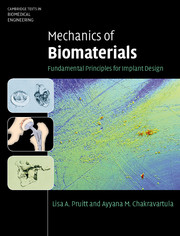Book contents
- Frontmatter
- Contents
- Symbols
- Prologue
- Part I Materials
- Part II Mechanics
- Part III Case studies
- 12 Regulatory affairs and testing
- 13 Orthopedics
- 14 Cardiovascular devices
- 15 Oral and maxillofacial devices
- 16 Soft tissue replacements
- Epilogue
- Appendix A Selected topics from mechanics of materials
- Appendix B Table of material properties of engineering biomaterials and tissues
- Appendix C Teaching methodologies in biomaterials
- Glossary
- Index
- References
13 - Orthopedics
from Part III - Case studies
Published online by Cambridge University Press: 05 June 2012
- Frontmatter
- Contents
- Symbols
- Prologue
- Part I Materials
- Part II Mechanics
- Part III Case studies
- 12 Regulatory affairs and testing
- 13 Orthopedics
- 14 Cardiovascular devices
- 15 Oral and maxillofacial devices
- 16 Soft tissue replacements
- Epilogue
- Appendix A Selected topics from mechanics of materials
- Appendix B Table of material properties of engineering biomaterials and tissues
- Appendix C Teaching methodologies in biomaterials
- Glossary
- Index
- References
Summary
Inquiry
How have we arrived at the modern-day implants used in orthopedics? What engineering design challenges do we face in orthopedic medical devices?
Contemporary implants have evolved from original attempts to restore function in articulation of a joint or stabilization of a fracture. However, many early designers did not fully understand the functionality of the musculoskeletal system or the behavior of materials in the body, and this often resulted in premature failure of the device. Much of our modern-day success is built upon learning from these earlier failures. Many design challenges remain in the development of orthopedic implants such as bone loss due to stress shielding, osteolysis owing to particulate debris, fractures associated with stress-corrosion mechanisms, biocompatibility, as well as patient and surgical factors. What other factors can you think of that contribute to the structural longevity of an orthopedic implant?
- Type
- Chapter
- Information
- Mechanics of BiomaterialsFundamental Principles for Implant Design, pp. 416 - 476Publisher: Cambridge University PressPrint publication year: 2011
References
- 3
- Cited by

